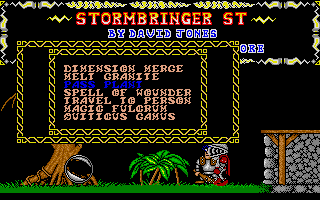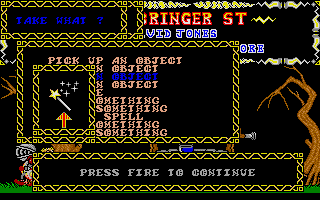Retro Replay Review
Gameplay
Stormbringer delivers a classic point-and-click adventure wrapped in a 16-bit package, challenging players to clear 64 interconnected screens. Instead of a traditional keyboard or mouse setup, Magic Knight’s actions are managed through a streamlined menu system. Pressing the fire button summons a context-sensitive list of actions—“examine,” “pick up,” “cast spell,” and more—allowing for quick decision-making as you explore each screen.
The depth of interaction stems from the sub-menus that follow each action command. Want to cast a spell? First select “cast spell,” then choose from your repertoire of enchantments. Looking to combine items? The “use” option will present you with everything in your inventory, from a humble chicken to a masterful disguise. This multi-layered interface encourages creative problem-solving, as you’ll often need to try several combinations before unravelling the puzzle of the next screen.
A notable new twist in Stormbringer’s gameplay is the lightning bolt hazard. Bolts periodically strike down from the sky, forcing you to time your movements and menu navigation carefully. This dynamic element raises the stakes, injecting a sense of urgency into what might otherwise be a leisurely exploration. Constant vigilance is required, as mistiming a menu selection could leave Magic Knight vulnerable to an untimely zap.
Completing the game hinges on strategic thinking and exploration. Every screen hides clues, hidden items, or critical pathways to reach the Off-White Knight’s castle hideout. While veteran adventure gamers may find the pacing deliberate, Stormbringer rewards patience with clever puzzles and a steady sense of progression. The balance between brain-teasers and environmental hazards like lightning ensures that each of the 64 screens feels distinct and purposeful.
Graphics
Stormbringer makes a strong impression as the series’ first—and only—venture onto 16-bit systems. The visual upgrade is immediate: richly detailed backgrounds set the tone for each environment, from shadowy forests to ominous castle corridors. Colors are vibrant without feeling garish, striking a fine balance between cartoonish charm and atmospheric depth.
Sprite work for Magic Knight and his foes exhibits smooth animations, particularly during the more dramatic sequences. The subtle flutter of Magic Knight’s cape, the sparkle of a casting spell, or the flash of lightning bolts all showcase the system’s capabilities. While you won’t find full-motion video or high-definition textures, the art style remains coherent and evocative throughout.
Environmental effects play a key role in immersing the player. Weather-worn stone walls, flickering torches, and shifting light patterns create a sense of place that goes beyond static screens. Special attention is given to the lightning mechanic: vivid streaks and realistic shadows sell the danger, making you respect each bolt’s potential to derail your progress.
Although Stormbringer’s visuals may feel retro by today’s standards, they stand up well against other 16-bit era titles. The graphical fidelity enhances gameplay clarity—objects and menu icons are easy to distinguish—while retaining the whimsical spirit that fans of Magic Knight have come to love.
Story
At its heart, Stormbringer continues the saga of Magic Knight, a hero whose quest now converges with his mysterious alter-ego, the Off-White Knight. This final chapter unfolds as a race against time and magical forces, driving Magic Knight through a labyrinthine world in search of his other self. The stakes feel personal, elevating the quest beyond a simple rescue or treasure hunt.
Storytelling unfolds primarily through environmental cues and textual prompts rather than lengthy cutscenes. Each screen contributes a piece of lore: graffiti on a dungeon wall hints at the Off-White Knight’s whereabouts, or a discarded scroll reveals a cryptic prophecy. This minimalist approach keeps the narrative momentum high, allowing players to fill in details as they progress.
The sense of duality between Magic Knight and his counterpart permeates the adventure. As you edge closer to the castle hideout, it becomes clear that reuniting with the Off-White Knight is more than a reunion—it’s a confrontation with a mirrored self. The emotional weight of that encounter gives the final screens dramatic significance, making the resolution feel earned.
For newcomers, the storyline offers enough context to remain engaging, though familiarity with previous Magic Knight titles enriches the experience. Longtime fans will appreciate subtle callbacks and recurring themes, from motif-driven puzzles to familiar locales revisited with new hazards and twists.
Overall Experience
Stormbringer succeeds in delivering a challenging, thoughtfully designed finale to the Magic Knight trilogy. The blend of puzzle-driven exploration, menu-based interaction, and environmental hazards ensures that each moment feels purposeful. While some players may find the interface cumbersome at first, it quickly becomes second nature, allowing the puzzles to shine.
The game’s 16-bit graphics offer a nostalgic yet vibrant world that remains clear and navigable. Coupled with a minimalist but effective narrative, Stormbringer crafts an immersive atmosphere that rewards curiosity. The introduction of lightning as a gameplay element adds tension and variety, giving the series a fresh dynamic just when it might have grown predictable.
As the concluding chapter, Stormbringer wraps up Magic Knight’s journey with a satisfying mixture of brain-teasers and storytelling. It strikes a fine balance between appealing to series veterans and welcoming new adventurers to its world. Though modern gamers accustomed to faster action or streamlined UIs might feel challenged by its deliberate pace, the game’s depth and charm compensate well.
For those seeking a retro-style adventure packed with puzzles, atmospheric graphics, and a compelling finale, Stormbringer stands out as a must-play. It may require patience and a love for methodical exploration, but the reward is a richly realized world and a fitting end to the saga of Magic Knight.
 Retro Replay Retro Replay gaming reviews, news, emulation, geek stuff and more!
Retro Replay Retro Replay gaming reviews, news, emulation, geek stuff and more!









Reviews
There are no reviews yet.